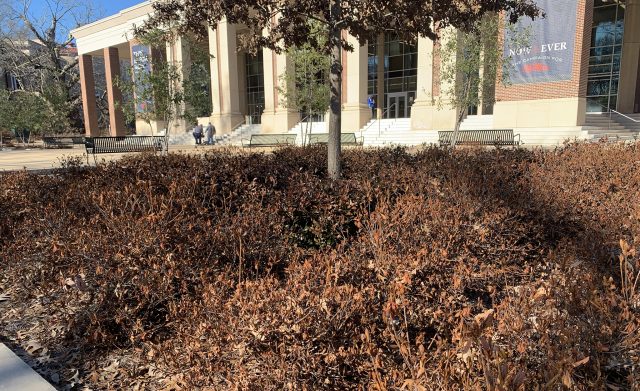Help Your Landscaping Recover From the Winter Freeze
The hard freeze that hit north Mississippi in December caused many normally hardy landscaping plants, such as these in front of the Ole Miss Student Union, to become discolored and lose leaves. Gardeners should take care to help plants recover from this freeze damage. Submitted photo
The weather event that occurred on Dec. 22, 2022, caused temperatures that had previously been consistent in the 50s to drop rapidly into the low teens with sub-zero wind chills within a few hours. These freezing temperatures remained in the area for three to four days.
This quick drop caused discoloring of leaves and defoliation of many landscaping plants, including many on the University of Mississippi campus, that usually remain evergreen and are hardy in the north Mississippi area.
During normal conditions, plants slowly reduce the amount of water and nutrients they pull into their vascular system as the temperatures drop. This rapid drop did not allow plants enough time to acclimate to the temperature changes, causing the water in the vascular system to freeze, damaging the plant cells.
What can be done?
This rapid freeze will most likely affect the flowers of spring blooming plants that set their buds on previous season growth, including azaleas, forsythia and winter jasmine. Temptation to take action and prune the plants now should be avoided as this could result in even more damage.
Even if the plant is damaged, the damaged material will protect viable plant parts from future cold snaps.
A “wait-and-see” approach is recommended to determine how the plants respond at the beginning of the growing season in the spring.
You can check for life in woody plants by scratching the bark on stems to see if the material underneath is green. If green coloring is found, the branch is still viable and alive.
Stems can also be bent slightly to see if they are still pliable. If the stem or branch snaps off, then it is likely dead. Look for green tissue inside the stem if it breaks to see if it is viable.
Pruning should not be performed until new spring growth emerges. In the spring, cut back stems and branches that do not leaf out back to live tissue to encourage new healthy growth.
Seasonal flowers
Cool season annuals such as pansies, dusty miller, kale and snapdragons were also affected by this rapid freeze. The plant tissues were damaged, causing plant tissue to “melt away.”
For these annuals, cleaning the dead and discolored material from the plant will reduce the risk of secondary fungal growth. Be careful when removing dead tissue, as live growth may be sheltered underneath.
Inspect to see if new growth has appeared below the dead material. Root balls can also be inspected to see if the roots are still viable. Liquid fertilizer can be applied when temperatures are above 50 to encourage new growth if the roots are viable or green shoots are emerging.
For more information, go to:
http://extension.msstate.edu/news/southern-gardening/2021/hard-freezes-challenge-southern-gardeners
Jeff McManus is director of landscape, airport and golf services at the University of Mississippi.


Comments are closed.